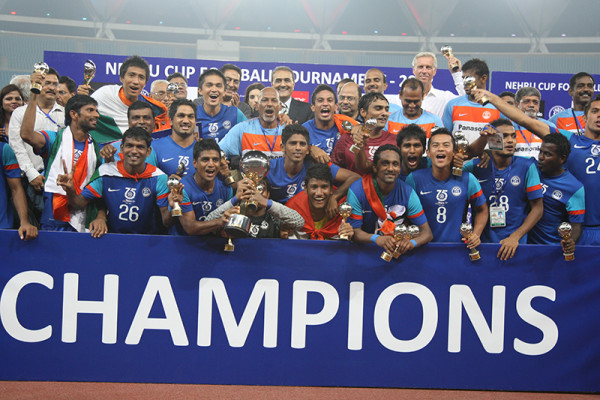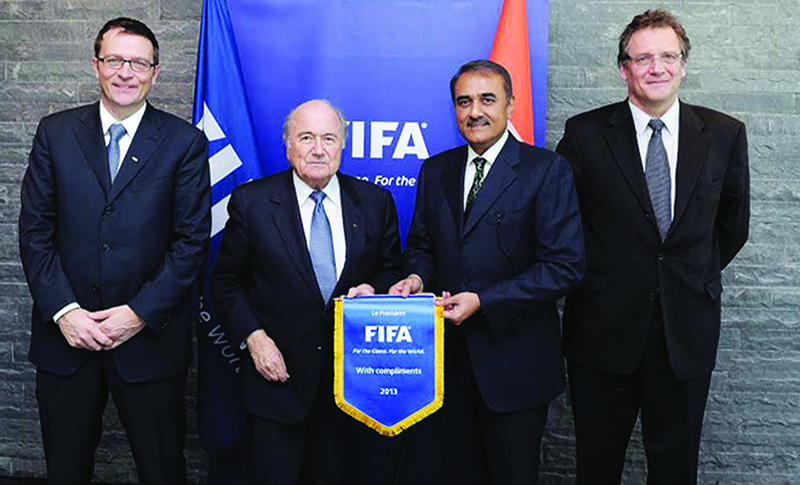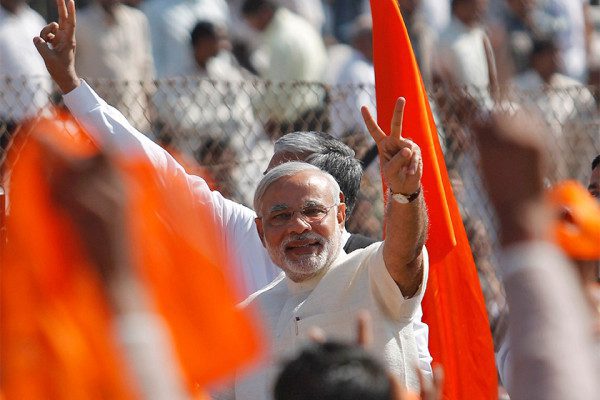The opportunity to host the U-17 World Cup has handed AIFF’s “Lakshya 2022” program a new lease of life. Arunava Ray discusses the feasibility of the whole project and the issues debilitating India’s quest for glory.
FIFA president Sepp Blatter had once famously de- fined India as the “sleeping giant” of football. With a population of 1.2 billion it is incomprehensible that a country of India’s stature languishes 156th in the FIFA rankings. However, the state of football in the country has been spiralling downwards since 1950 when the Government refused the Indian team the chance to participate in the fourth edition of the FIFA World Cup. The decision shall go down in history as the moment that stunted the growth of football in the country.
With only 15 nations participating and drawn in a group with the likes of Italy, Paraguay and Sweden it was India’s chance to re-create the Kapil Dev moment of Indian foot- ball and etch their names in history as one of the pioneers of world football. Instead, we are grovelling under a mass of inept management and lack of infrastructure which has blunted our capacity to make a statement for years to come. However, amidst the squalor and putrid ineptitude, the harrowing state of Indian football received a beacon of hope on 2nd September 2012, when a young Indian side beat Cameroon, a side placed more than 100 places above them in the FIFA rankings to lift the Nehru Cup. The All India Football Association(AIFF) were quick to claim the victory as their own and jumped on the opportunity to announce a plan which shall see India qualify for the 2022 FIFA World Cup. “Lakshya 2022”
Speaking to a press conference immediately after India’s historic win, Patel said, “India has never been a one sport nation. Today, India is the home of world cricket and we are certain that in the years to come, football will regain its lost glory. Our vision document LAKSHYA has been well received by the FIFA and we are working towards having our presence felt at the FIFA World Cup, 2022.”
However, a whole year had passed in anticipation before the AIFF were vested yet another historic triumph by the FIFA as they gave India the rights to host the U-17 FIFA World Cup in 2017. The Government officials were quick to claim credit for their concerted efforts as the whole nation joined hands in contemplation of India’s first ever participation in a World Cup. AIFF secretary Kushal Das promised the inauguration of two U-17 academies and a youth league in the upcoming days to facilitate India’s preparation for the event.
“This tournament could certainly change the face of the game in the country. FIFA will bear the cost of the tournament, around $7-8 million, but the rest we have to raise. The benefits are incalculable. Our top priority remains two world class U-17 academies and a competitive team for the tournament. We also want to start immediately U-14 and U-16 leagues and all the I-League clubs are on board for it,” said Das.
But is money the only factor that is keeping Indian football from taking the leap? Would an investment of a few hundred crores eradicate the void that has engulfed the sport for more than six decades? The biggest question thronging the minds of millions of football lovers across the country, can AIFF promote the sport enough that they can overthrow cricket as the most loved sport in the country?
Mr. Patel thinks that is possible. He says, “We have to ensure football is the No. 1 sport in the country and for that to happen the platform has been laid.”

However, from a practical standpoint, it will take much more than money to bring India anywhere close to competing with the biggest forces in world football, especially as early as 2022. The biggest problem that faces India is the lack of importance given to domestic football. More people are enamoured to the international leagues given the quality of football, something which is vastly lacking in the current Indian circuit. The attendance, barring in derbies, has come down to a trickle in spite of most stadiums charging a pittance for games. The reason, according to Swarnadeep Chatterjee, a staunch follower of Mohun Bagan and a regular at the Salt Lake Stadium, is owing to a lack of planning when making the fixtures.
“Admins in the federation do not know what they are doing. There is absolutely no planning that goes into making the fixture list. Matches are held randomly on weekdays which consequently draw less crowds,” goes his protestations.
However, the same is refuted by the biggest league in the world, the English premier League, where they play up to three games a week and yet the attendance levels are never at a loss. The AIFF should take a leaf out of their book and realise that the sport can only be taken forward with an injunction of real quality, something which is amiss in the current Indian setup. The I-League teams depend on foreigners to lead their line, something which has stunted India’s growth over the years. Players from Africa, built like a tank and with an innate ability to hold the ball take preference over an average Indian player, malnourished and with minimal coaching.
But the fact that the best players in a team are foreigners, defeats the purpose of a league whose sole objective is to promote talented players into the national team. The whole format has failed to transform the Indian football scene from the grassroot level and there are growing concerns that an IPL style franchisee based league, which shall play hosts to the likes of legends like Robert Pires and Tony Adams will fail to have an impact. Kolkata has seen the likes of Lionel Messi, Sergio Aguero and Angel di Maria play in a competitive friendly at the Salt Lake Stadium last year, but the enthusiasm among people quickly shifted to the next cricket match that was being aired on TV. Diego Maradona and Diego Forlan have all been to the city in recent years, but have failed to hold the euphoria for much long after their departure.
However, all is not lost for budding footballers in India. The awareness among people is rising and the Commonwealth games have shown that if needed, our country can step up and produce world class facilities and attract the best talent from across the world. But for the AIFF to be anywhere close to achieving their dream to see India participate in the World Cup in 2022, they need support from the major industrialists from across the country to invest in the sport. When the AIFF signed a 15 year deal worth a whopping 700 crores with Reliance and IMG in 2010, it was seen as a major step forward for Indian football. But little has changed thus far, with the past three years mostly spent in alleviating a squabble between the two parties over television rights and other measly encounters.
The AIFF has rested their faith on the U-17 World Cup to transform the fate of Indian football, but it will go in vain if immediate attention is not paid to the problems that keep staring us in the eye.
Advertisements. Cricket has an ad slot for every six balls, which is a major source of income for the distributors. The fall of a wicket, an injury or a disturbance earns its place in lakhs owing to the space allotted to advertisers. Whereas in football, advertisements are concentrated to the half time interval and a couple of hoardings along the periphery of the ground. From an Indian perspective, it will be impossible for broadcasters to generate the amount of money in football, which they can through endorsements in cricket. However, Football revenues are higher as a whole in other parts of the world due to their worldwide reach, something which will not work for Indian football in the short run.
Money. The advent of the Indian Premier League(IPL) has brought a host of problems along with it. Any budding sportsman can now look at the IPL auction and realise that a few years of hard work can get them a place on the list, which will assuage their monetary problems for the rest of their lives. Can the AIFF give a budding cricketer a good reason to switch to football? Because only passion doesn’t fill stomachs.
Culture. For football to thrive, it has to be inccorporated into the part and parcel of a nation’s culture. Brazil, similar to India in terms of economic growth has more than 10,000 players playing professionally across the world, earning plaudits and keeping the flag flying high. For them, it is a pastime, when kids from neighbouring houses come together for an evening of fun and frolic. While in India, parks are overrun by cricketers who aim to break into the IPL and make a life for themselves. Everyday a potential Messi or a Ronaldo gets shooed off the field because the people in India are not willing to give another game a chance to grow. Till the people in the country get their priorities straight and stop calling themselves football fans on the basis of international leagues, the most popular sport in the world will continue to writhe in despair.
It is blasphemous that a country with more than 1.2 billion people cannot churn out 11 people who can match the best in the world. Arguments have been made about physical attributes which we lack genetically but the fact that we were among the best in the world in Hockey refutes the point.
India needs a Sachin Tendulkar in football who can revolutionise the state of the sport. A someone whose brilliance will rub off on the fates of millions around him. The people in India have fasted, prayed and cried with Tendulkar through the length of his journey and the country needs a similar figure in football to erupt from the ashes like a pheonix and put the game into perspective. Till then Lakshya 2022, will turn to 2034 and so on, until the whole country gives up on the game as a whole.














